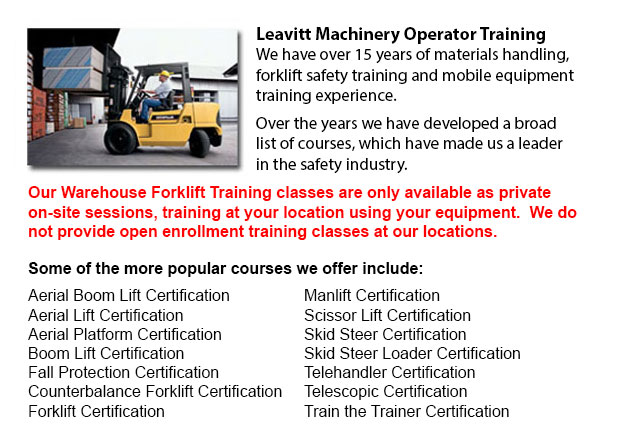
Langley Warehouse Forklift Training Programs - Warehouses can either be industrial, commercial or retail facilities, functioning from product distribution services to bulk product retailing. Regardless of the kind of warehouse, personnel inside warehouse settings should be trained correctly in safety procedures related to material handling and storage, loading docks, conveyor systems, and pallet jacks and forklifts. Good housekeeping is important to a safe and orderly warehouse setting.
The loading dock system is normally build into the warehouse at a height from the ground making it easy to move items moving out and coming in of the warehouse. Personnel would likewise unload and load merchandise and materials from the elevated docks and ramps. Particular attention must be paid to safety habits in this stage. In order to avoid falls, install yellow striping along the edge of ramps and docks. Pay attention to the area around delivery trucks which are parked at the loading dock, particularly the area between truck and dock. Be sure that when unloading, truck wheels are chocked.
In order to distribute products in the facility, some warehouses make use of a conveyor system. These systems are designed with moving belts and wheels that may pose a pinch point hazard. Keep body parts and hair well away from conveyors to avoid injury. Elevated conveyors pose a danger to employees under if safety nets are absent. Personnel should know how to stop conveyors in the event of emergency. Be aware of the location of emergency stop buttons and off switches. When servicing conveyors, tag out/lock out procedures are mandatory.
Forklifts and pallet jacks are designed to move materials all-around the warehouse. Forklift operators are required to take training and be given certification. Operators of pallet jacks do not require certification, but must be trained about the machine. Training programs instruct operators in the proper methods for lifting materials and transporting them to their assigned location. Neither forklifts nor pallet jacks should ever be used to lift or transport personnel.
To allow for sufficient room for machines and individuals to pass, storage shelving and rack systems help to create an efficient and orderly work space, particularly if they are properly braced. Slow and careful placement of good is required to prevent accidents caused by products falling off the facing aisle. Aisles should be kept clear by storing products flat and inside the shelving units. Pallets are utilized for stacking products. They must be in good condition, and palleted products must be shrink-wrapped or baled, whenever possible.
PPE or personal protective equipment must be worn when required to help protect the workers' limbs, heads, hands and feet. Hard hats or bump caps, steel-toed shoes and gloves are common PPE.
Slippery floors pocked with dents and pits present a danger. Good housekeeping habits involve keeping warehouse docks and floors clear of debris, oil and dirt. The area must be kept clear of baling materials, garbage and boxes.
-
Operator Safety Certification | Re-Qualification Certification | In-House Instructor Certification in Langley
Lift trucks are utilized in nearly all warehouse operations and in boat yards and in industrial construction sites. The reach feature of a forklift is a vital component used in several applications like for example whenever a shelving system is being... More -
Skid Steer Loader Certification in Langley
The engine powered skid-steer loader consists of a small and rigid frame, equipped along with lift arms that could connect to numerous industrial attachments and tools to carry out several labor saving jobs. Normally, skid-steer loaders are four-whee... More -
Langley Forklift Training Classes
Langley Forklift Training Classes - Forklift are heavy pieces of industrial machines that are utilized in transporting and the handling of merchandise and materials. They are often known as Lift trucks and are found in all kinds of industries. Employ... More -
Langley Heavy Equipment Operator Certification
Langley Heavy Equipment Operator Certification - The heavy equipment operator is an individual who manipulates the controls and drives various kinds of big machinery. Heavy machines is most commonly used on construction sites in order to deliver supp... More -
Langley Crane License
Langley Crane License - Crane operators ought to be "credentialed", which means they ought to own a crane operator license or certification. Credentialing is considered a mandatory governmental prerequisite to be able to practice as a crane operator.... More -
Langley Forklift Training School
Langley Forklift Training School - Forklift Training School And What It Truly Has To Provide - Industry and federal regulators have established the criteria for forklift safety training according to their current standards and regulations. People wis... More -
Langley Boom Lift Certification
Langley Boom Lift Certification - Elevated work platforms allow maintenance operations and work to be performed at heights that can not be reached by whichever other way. Workers utilizing boom lifts and scissor lifts could learn how to safely operat... More -
Langley Manlift Safety Training
Langley Manlift Safety Training - Manlift operators need to be cognizant and aware of all the potential dangers which are connected with specific classes of scissor lifts. They have to be able to operate the scissor lift in a way that protects not on... More

Forklift Certification Langley
TOLL FREE: 1-888-254-6157
Langley, British Columbia
forkliftcertificationlangley.com
Email Us
About Us


